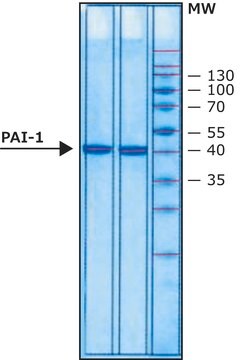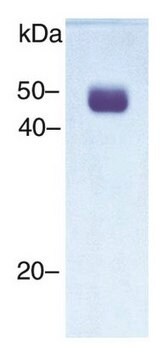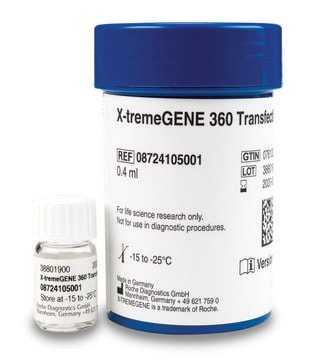CC4075
Human Plasminogen activator inhibitor-1, recombinant
Synonyme(s) :
PAI 1, SERPINE1, PAI1
Se connecterpour consulter vos tarifs contractuels et ceux de votre entreprise/organisme
About This Item
Code UNSPSC :
12352202
eCl@ss :
32160405
Produits recommandés
Description générale
Plasminogen activator inhibitor-1 (PAI-1) is a member of the serine protease inhibitor (serpin) superfamily and a central regulatory protein in the blood coagulation system. PAI-1 is unique among serpins in exhibiting distinct active and inactive (latent) conformations in vivo. Human PAI-1 is a single-chain glycoprotein with a molecular weight of 43 kDa. This inhibitor acts as "bait" for tissue-type and urokinase-type plasminogen activators (tPA and uPA) and protein C. Its rapid interaction with tPA may function as a major control point in the regulation of fibrinolysis. The highly mobile reactive-center loop (RCL) is thought to account for both the rapid inhibiton of plasminogen activators, and the rapid and spontaneous transition of the unstable, active form of PAI-1 into the stable, inactive conformation (t1/2 at 37oC, 2 hours). The inactive form can be partially reactivated by denaturants such as urea, guanidine hydrochloride or SDS. High concentrations of PAI-1 have been associated with human thromboembolic disease. PAI-1 activity may limit the extent of tumor metastasis, since uPA activity is a major contributory factor promoting dissolution of tumor matrix and basement membrane.
The sequence corresponding to amino acids 24 to 402 of human PAI-1 (mature form) tagged with 6xHis on the carboxy-terminal was expressed in E. Coli.
Application
To fully activate the latent PAI-1, the PAI-1 must be incubated in Activation Buffer (2X Activation Buffer: 8 M Guanidine HCl, 40 mM Sodium Acetate, pH 5.6, 400 mM NaCl, 0.2% Tween 20) for 15 to 30 minutes (Sancho, 1994).The recombinant PAI-1 is able to bind to uPA resulting in a SDS-stable complex.
Forme physique
Liquid. In 150 mM Na2HPO4, pH 6.6, 500 mM NaCl, 2 mM Glutathione, and 0.01% Tween-80.
Stockage et stabilité
Store at -80ºC. Thaw on ice and freeze aliquots at -80ºC for longer storage. This product is stable for at least 2 years as supplied. Avoid repeated freeze/thaw cycles.
Remarque sur l'analyse
Specific Activity: By uPA activity assay, the recombinant PAI-1 contains a mixture of the active and latent forms, with >45% of active form
Informations légales
CHEMICON is a registered trademark of Merck KGaA, Darmstadt, Germany
Clause de non-responsabilité
Unless otherwise stated in our catalog or other company documentation accompanying the product(s), our products are intended for research use only and are not to be used for any other purpose, which includes but is not limited to, unauthorized commercial uses, in vitro diagnostic uses, ex vivo or in vivo therapeutic uses or any type of consumption or application to humans or animals.
Code de la classe de stockage
12 - Non Combustible Liquids
Classe de danger pour l'eau (WGK)
WGK 2
Point d'éclair (°F)
Not applicable
Point d'éclair (°C)
Not applicable
Certificats d'analyse (COA)
Recherchez un Certificats d'analyse (COA) en saisissant le numéro de lot du produit. Les numéros de lot figurent sur l'étiquette du produit après les mots "Lot" ou "Batch".
Déjà en possession de ce produit ?
Retrouvez la documentation relative aux produits que vous avez récemment achetés dans la Bibliothèque de documents.
P M Sherman et al.
The Journal of biological chemistry, 267(11), 7588-7595 (1992-04-15)
Plasminogen activator inhibitor-1 (PAI-1) is a specific inhibitor of the serine proteases tissue-type plasminogen activator (tPA) and urokinase-type plasminogen activator (uPA). To systematically investigate the roles of the reactive center P1 and P1' residues in PAI-1 function, saturation mutagenesis was
Notre équipe de scientifiques dispose d'une expérience dans tous les secteurs de la recherche, notamment en sciences de la vie, science des matériaux, synthèse chimique, chromatographie, analyse et dans de nombreux autres domaines..
Contacter notre Service technique





